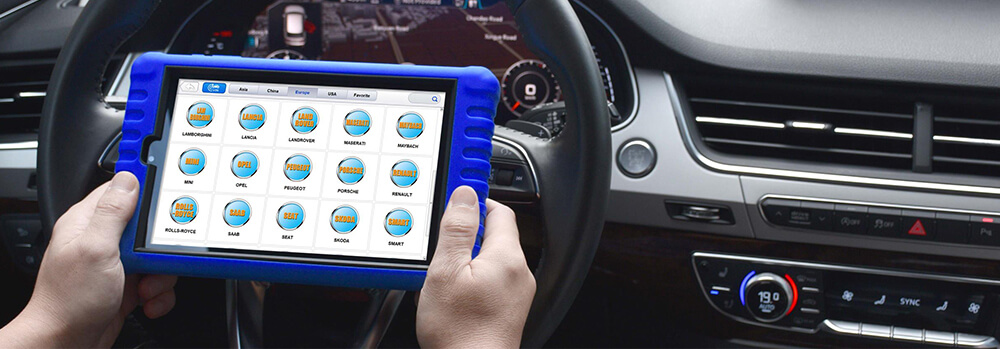DIAGNOSE YOUR CAR WITH LESS KNOWLEDGE ABOUT THE CAR
2023-02-02 by UDIAG
The most fundamental automotive issues aren’t easy to resolve. The difficulty in diagnosing and fixing problems grows as vehicles become more sophisticated and integrate new computer-controlled components and complex drivetrains.
If you’re not mechanically inclined, sorting out the causes of car issues is a difficult task. There’s a level of diagnosing that is accomplished by anyone using their senses. That is because most cars will consistently have certain symptoms that correspond to specific issues. At the very least, being able to identify the area in which the issue lies is an essential step to identifying the cause of automotive problems. There are some ways to find car problems.

1. Smelling
Different smells on the inside or outside of your car can indicate issues with your car. Unlike with noise or vibration, unusual smells are easier to detect because they are usually more noticeable. It is important to be vigilant of strange smells in your car. Here are some smells to check for.
-
Exhaust fumes in your car
Exhaust fumes should be alarming. This is a sign that exhaust gas has gotten into the cabin from underneath it.
If you notice exhaust gas from your vehicle stop driving and contact an experienced mechanic to look into the problem before you drive again. Carbon monoxide inhalation can cause brain damage, and possibly death.
-
Look for the scent of gasoline or oil
The presence of gas or oil in the engine compartment is usually a sign of leaks.
It is possible for gas to leak around the tank as well as under the car, but this could cause puddles of fuel to build up on the pavement. This is most likely to be noticed first.
You should immediately get an engineer to investigate these smells because they could cause more serious issues.
-
Examine the smell of coolant
Coolant has a distinctive and delicious car scent which is distinguished from other smells that are related to leaks.
If coolant leaks, it is likely that the engine isn’t adequately cooled, and could be damaged by excessive heat. Consult a professional who is qualified to address any issue with an unidentified smell in the vehicle.
-
Check for the smell of sulfur
If they’re malfunctioning or damaged, it is possible that sulfur smell could release from a variety of components. These include the battery and catalytic converter. If the battery gets overcharged or the catalytic converter begins to fail, then you’ll notice the sulfur smell in the vicinity of the vehicle. In certain instances, issues with the fuel system can create this odor.
-
Look for the scent of burnt wood or rubber
Components that experience excessive heat or friction up could emit an odor that is similar to burning rubber or wood. Parts such as the brake pads or the clutch are prone to producing these smells.
-
Look for the scent of mold or mildew
The issue could be related to your air circulation system if the interior smells of mold or mildew. The smell is likely to originate from the cabin air filter, especially if it has not been replaced in the last few months. The smell could be due to issues with the AC or heating system.
2. Touching
To determine the cause of car issues by through your sense of touch, you don’t need to walk around and physically touch every part of your car. Instead, you can use your sense of touch to recognize unusual vibrations or other signs that something isn’t right.
-
Examine the components of the center console and dashboard
While the car is parked, inspect the dashboard and center console components to ensure that they are functioning properly.
-
Examine the AC vents
To ensure cold air is being blown by the fan, turn the control to the highest setting. Contact a certified technician to determine if you suspect that your AC system isn’t functioning properly or the controls aren’t working correctly.
-
Take a look at the steering wheel
You can feel any issues through the steering wheel when you hold the steering wheel with your hands.
If the steering wheel is shaking or vibrating it could indicate a problem with the wheels or brakes. The problem lies caused by the ball joints or tie rods when the steering wheel is feeling loose. It could be that the steering wheel is difficult to turn.
If your steering wheel isn’t functioning properly, it is a problem with the steering column or steering rack.
-
Feel the pedals
Your feet are beneficial in diagnosing issues. It is easy to determine the cause of a problem using any pedal.
If there is an issue with the gas pedal, like a lack of throttle response or if the pedal sticks on the floor it is probably a mechanical issue in the engine, fuel delivery system, or return spring on the pedal.
The issue may lie in the brake system of the vehicle, in the event that the brake pedal shakes or causes unintended steering. If the pedal vibrates the pedal, it’s likely to be due to a problem with the brake rotors.
If your car has a manual transmission, then you’ll also have a clutch pedal to deal with. An abrupt lack of resistance in the clutch pedal can cause it to slide all the way to the ground, but not return to its normal.
3. Listening
You should pay attention to the sound of your car as it turns on and off while you are driving.
You can become familiar with the sounds of your car when it’s functioning properly, so you will know the signs that something isn’t working.
A squeaking or creaking sound while steering or turning can indicate a number of problems that range from worn shocks and ball joints to damaged suspension.
On the other hand, clicking or popping sounds might indicate loose hubcaps, drive belts, worn-out or imbalanced tires, or engine oil that is low. Strange noises during braking could be due to problems with the brake pads or a backfiring sound can be caused by even more dangerous situations, such as water in the fuel system, or a malfunctioning air intake valve.
Any unusual sounds should be noted and reported to a mechanic qualified to determine the cause.
4. Looking out for
Driving is an experience that you can enjoy. Your eyes must be focus on the road ahead. The dashboard is something you must be aware of. You can see a variety of indicators on your dashboard to signal that you’re in trouble. The Check Engine light is the most important indicator to look out for. If you find that the light has illuminated your dashboard, have it examined by a qualified technician from your mechanic.



